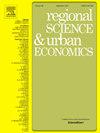商业地产中的古着效应和建筑环境的动态
IF 2.9
2区 经济学
Q1 ECONOMICS
引用次数: 0
摘要
本文论证了老商业建筑的价格相对于新商业建筑的价格上涨。我们认为,这是一种“复古效应”,是由于在不断扩大的市场中,老建筑的边际居住者对老建筑的估值不断上升。我们表明,这种影响不是由于当地的价格趋势,或上市或保护区。此外,它并不局限于城市地点或从主干道上可见的建筑物,在1960年以前建造的建筑物中最为明显。重复销售分析证实了享乐回归的结果。对办公楼市场的进一步分析证实,老旧建筑的生存概率和入住率最高。这些发现表明,商业建筑的寿命比通常认为的要长,这使得建筑环境缺乏活力。本文章由计算机程序翻译,如有差异,请以英文原文为准。
Vintage effects in commercial real estate and the dynamics of the built environment
This paper demonstrates that the prices of older commercial buildings increase relative to younger ones. We argue that this is a ‘vintage effect’ that is due to the increasing valuation of older buildings by their marginal occupant in an expanding market. We show that this effect is not due to local price trends, or listing or preservation zones. Furthermore, it is not confined to urban locations or buildings visible from main roads, and it is most pronounced for buildings constructed before 1960. Repeat sales analysis confirms the results of hedonic regressions. Further analysis of the office market, for which the vintage effect is strongest, confirms that survival probabilities and occupancy rates are highest for older buildings. These findings suggest that commercial buildings have a longer lifespan than is often thought, making the built environment less dynamic.
求助全文
通过发布文献求助,成功后即可免费获取论文全文。
去求助
来源期刊

Regional Science and Urban Economics
Multiple-
CiteScore
5.30
自引率
9.70%
发文量
63
期刊介绍:
Regional Science and Urban Economics facilitates and encourages high-quality scholarship on important issues in regional and urban economics. It publishes significant contributions that are theoretical or empirical, positive or normative. It solicits original papers with a spatial dimension that can be of interest to economists. Empirical papers studying causal mechanisms are expected to propose a convincing identification strategy.
 求助内容:
求助内容: 应助结果提醒方式:
应助结果提醒方式:


